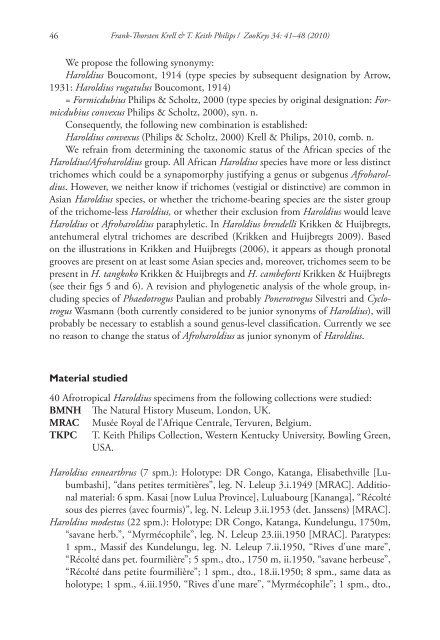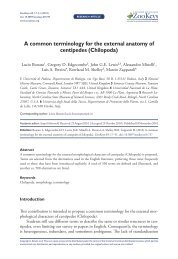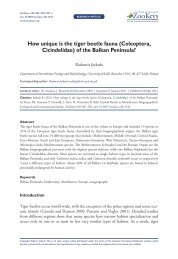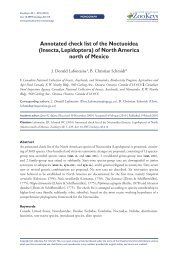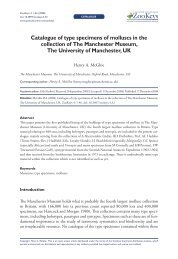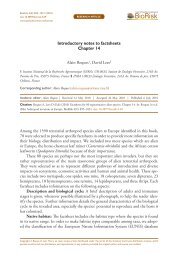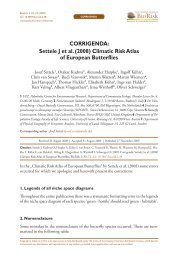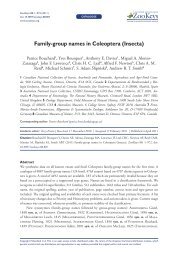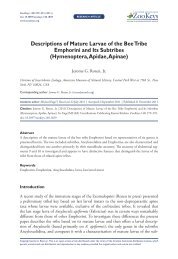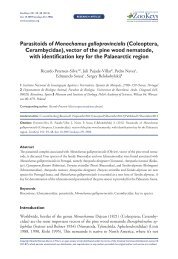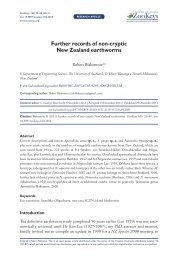Formicdubius Philips & Scholtz from South Africa, a junior synonym ...
Formicdubius Philips & Scholtz from South Africa, a junior synonym ...
Formicdubius Philips & Scholtz from South Africa, a junior synonym ...
You also want an ePaper? Increase the reach of your titles
YUMPU automatically turns print PDFs into web optimized ePapers that Google loves.
46<br />
Frank-Th orsten Krell & T. Keith <strong>Philips</strong> / ZooKeys 34: 41–48 (2010)<br />
We propose the following <strong>synonym</strong>y:<br />
Haroldius Boucomont, 1914 (type species by subsequent designation by Arrow,<br />
1931: Haroldius rugatulus Boucomont, 1914)<br />
= <strong>Formicdubius</strong> <strong>Philips</strong> & <strong>Scholtz</strong>, 2000 (type species by original designation: <strong>Formicdubius</strong><br />
convexus <strong>Philips</strong> & <strong>Scholtz</strong>, 2000), syn. n.<br />
Consequently, the following new combination is established:<br />
Haroldius convexus (<strong>Philips</strong> & <strong>Scholtz</strong>, 2000) Krell & <strong>Philips</strong>, 2010, comb. n.<br />
We refrain <strong>from</strong> determining the taxonomic status of the <strong>Africa</strong>n species of the<br />
Haroldius/Afroharoldius group. All <strong>Africa</strong>n Haroldius species have more or less distinct<br />
trichomes which could be a synapomorphy justifying a genus or subgenus Afroharoldius.<br />
However, we neither know if trichomes (vestigial or distinctive) are common in<br />
Asian Haroldius species, or whether the trichome-bearing species are the sister group<br />
of the trichome-less Haroldius, or whether their exclusion <strong>from</strong> Haroldius would leave<br />
Haroldius or Afroharoldius paraphyletic. In Haroldius brendelli Krikken & Huijbregts,<br />
antehumeral elytral trichomes are described (Krikken and Huijbregts 2009). Based<br />
on the illustrations in Krikken and Huijbregts (2006), it appears as though pronotal<br />
grooves are present on at least some Asian species and, moreover, trichomes seem to be<br />
present in H. tangkoko Krikken & Huijbregts and H. cambeforti Krikken & Huijbregts<br />
(see their fi gs 5 and 6). A revision and phylogenetic analysis of the whole group, including<br />
species of Phaedotrogus Paulian and probably Ponerotrogus Silvestri and Cyclotrogus<br />
Wasmann (both currently considered to be <strong>junior</strong> <strong>synonym</strong>s of Haroldius), will<br />
probably be necessary to establish a sound genus-level classifi cation. Currently we see<br />
no reason to change the status of Afroharoldius as <strong>junior</strong> <strong>synonym</strong> of Haroldius.<br />
Material studied<br />
40 Afrotropical Haroldius specimens <strong>from</strong> the following collections were studied:<br />
BMNH Th e Natural History Museum, London, UK.<br />
MRAC Musée Royal de l’Afrique Centrale, Tervuren, Belgium.<br />
TKPC T. Keith <strong>Philips</strong> Collection, Western Kentucky University, Bowling Green,<br />
USA.<br />
Haroldius ennearthrus (7 spm.): Holotype: DR Congo, Katanga, Elisabethville [Lubumbashi],<br />
“dans petites termitières”, leg. N. Leleup 3.i.1949 [MRAC]. Additional<br />
material: 6 spm. Kasai [now Lulua Province], Luluabourg [Kananga], “Récolté<br />
sous des pierres (avec fourmis)”, leg. N. Leleup 3.ii.1953 (det. Janssens) [MRAC].<br />
Haroldius modestus (22 spm.): Holotype: DR Congo, Katanga, Kundelungu, 1750m,<br />
“savane herb.”, “Myrmécophile”, leg. N. Leleup 23.iii.1950 [MRAC]. Paratypes:<br />
1 spm., Massif des Kundelungu, leg. N. Leleup 7.ii.1950, “Rives d’une mare”,<br />
“Récolté dans pet. fourmilière”; 5 spm., dto., 1750 m, ii.1950, “savane herbeuse”,<br />
“Récolté dans petite fourmilière”; 1 spm., dto., 18.ii.1950; 8 spm., same data as<br />
holotype; 1 spm., 4.iii.1950, “Rives d’une mare”, “Myrmécophile”; 1 spm., dto.,


